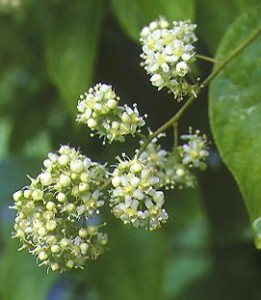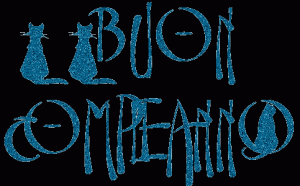An aunt and uncle of Stefano’s spent the Xmas 2007 holiday with us. One day I told Stefano’s plant-loving aunt about parthenolide, or PTL, the active myeloma-cell-killing ingredient in the feverfew plant.  She recognized the Latin name of feverfew (Tanacetum parthenium) and gasped: “But my mother has this plant growing WILD in her back yard!” Oh, you can imagine my delight at this bit of news! She promised to dig up and send me a bit of this plant as soon as spring arrived. So I now have a pretty little feverfew plant in my front yard (see the photo I took this morning). Now, I am not sure what I will be doing with it (preparing teas, perhaps? The highest concentrations of PTL, I read, are in the flowers and fruit of feverfew) but at the very least I am sure it will bring me good luck.
She recognized the Latin name of feverfew (Tanacetum parthenium) and gasped: “But my mother has this plant growing WILD in her back yard!” Oh, you can imagine my delight at this bit of news! She promised to dig up and send me a bit of this plant as soon as spring arrived. So I now have a pretty little feverfew plant in my front yard (see the photo I took this morning). Now, I am not sure what I will be doing with it (preparing teas, perhaps? The highest concentrations of PTL, I read, are in the flowers and fruit of feverfew) but at the very least I am sure it will bring me good luck.
I used this little story and my photo as an introduction to today’s post about a recent U.S. study on the anti-myeloma effects of partenolide. I have already posted about two previous studies on the same topic–one Chinese, the other Japanese. For background info, please see my Page on parthenolide/DMAPT.
A blogging friend (thank you!!!) sent me the full text of this Indiana University School of Medicine study published in Clinical Cancer Research on March 15th 2008. In the abstract (http://tinyurl.com/5xxsu5) we can read that PTL has multifaceted antitumor effects toward both MM cells and the bone marrow microenvironment. Excellent starting point, I’d say! Okay, with no further ado, I will plunge right into the study.
The beginning of the full study has some interesting wording: Despite intensive chemotherapy, multiple myeloma (MM) remains an incurable, yet chronic, blood cancer with over 14,000 patients diagnosed and 45,000 patients treated yearly in the United States The interaction of MM cells with the bone marrow microenvironment contributes to the heterogeneous treatment response and drug resistance.. Incurable, yet chronic, did you notice that? Hmmm, I think this may be the first study I have looked at so far that mentions the adjective “chronic” in the same breath as “myeloma.” Well, well.
Reading on, when myeloma cells adhere to the bone marrow stromal cells (BMSC), that is, to the cells and the supporting tissue that surround the myeloma cells in our bone marrow, NF-kappaB activation in the BMSCs up-regulates interleukin-6 (IL-6) and vascular endothelial growth factors, which further enhance MM cell growth both directly and, in the case of vascular endothelial growth factor, also indirectly via promoting angiogenesis. Vascular endothelial growth factor is abbreviated as VEGF and, in a nutshell, is a tumour-feeder.
The researchers identify NF-kappaB as the main culprit in the myeloma proliferation process, since it affects both the tumor cells and the supporting microenvironment.
And it just so happens that parthenolide inhibits NF-kappaB (as do curcumin and practically every substance that I have researched and posted about here!). Its anti-tumour effects have been observed in various cancers, including breast, lung, prostate, cholangiocarcinoma, and acute myeloid leukemia. It also increases the effectiveness of chemotherapy, which might be of interest to those who are doing chemo right now.
Interesting titbit: one of the anti-myeloma strategies criticized by the Indiana researchers is the use of Bortezomib (Velcade), in this sense: the proteosomal inhibition in normal cells can lead to significant side effects due to the accumulation of toxins, which would otherwise be removed by a fully functional proteosome. The Indiana researchers argue that targeting NF-kappaB might instead lower toxicities while maintaining efficacy. Hmmm.
At any rate, the researchers tested parthenolide in myeloma cell lines that had become resistant to dexamethasone and doxorubicin. After 72 hours, PTL inhibited the proliferation of these resistant cells.
Now, since I know a few myeloma folks who are taking dexamethasone, here is some info on PTL used with dex. The researchers found out that this combination is synergistic.
Here is the gist: Parthenolide activates both the extrinsic and intrinsic apoptotic pathways, whereas other anti-MM treatments, including conventional chemotherapy, radiation, and glucocorticoid, primarily activate the intrinsic apoptotic pathway. We hypothesize that simultaneous activation of both apoptotic pathways may enhance cytotoxicity. Our finding of an additive cytotoxicity with the parthenolide and dexamethasone combination supports this concept.
Oh, you may ask what “extrinsic” versus “intrinsic” apoptotic pathway means? Good question. Not easy to answer, but basically the death of a cancer cell can be caused by “die, you scoundrel!!!” signals transmitted by so-called “death receptors” located on the cell’s surface, that is, external (to the cell) signals, or by death signals that originate inside the cell such as those deriving from DNA damage or from chemotherapy.
The researchers also found that PTL is toxic only to myeloma cells, not to the surrounding healthy ones. Now, haven’t I read that BEFORE?
Parthenolide also attenuated the protective effect of the bone marrow microenvironment on myeloma cells. And IL-6 was unable to protect the myeloma cells from the toxic effect of this powerful plant extract. For the scientifically-minded: Parthenolide inhibited the NF-kappaB–DNA binding and further reversed the effect of TNF-alpha–induced NF-nB activation.
The study concludes that parthenolide is effective against MM cells in the context of the bone marrow microenvironment and that its mechanisms of action are both caspase-dependent and independent. In combined therapy, parthenolide is additive and synergistic with dexamethasone and TRAIL, respectively. Our findings provide a rationale for the clinical development of parthenolide. (TRAIL, by the way, stands for TNF-related apoptosis-inducing ligand; basically, it helps induce apoptosis in cancer cells.)
How about that?
![]() ) That is why my endocrinologist wants me to suspend my intake of vitamin D until the fall. If I don’t do so, she won’t be able to figure out the cause of my elevated parathyroid hormone.
) That is why my endocrinologist wants me to suspend my intake of vitamin D until the fall. If I don’t do so, she won’t be able to figure out the cause of my elevated parathyroid hormone.


